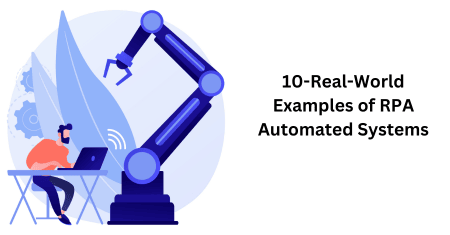
25 May 10-Real-World Examples of RPA Automated Systems
25 May 2023

Robotic Process Automation (RPA) has emerged as a powerful technology that automates repetitive tasks and streamlines business processes. By mimicking human actions, RPA software can handle complex workflows with precision and efficiency. In this article, we will explore ten real-world examples of RPA automated systems, demonstrating how organizations across various industries have leveraged this technology to improve their operations and achieve tangible benefits.
What is RPA?
Robotic Process Automation (RPA) is a cutting-edge technology that revolutionizes business processes by automating repetitive manual tasks. Contrary to its name, RPA does not involve physical robots performing physical labor. Instead, it utilizes virtual software bots to mimic human actions and interact with digital systems and software.
RPA software enables organizations to develop, deploy, and manage these software bots effectively. These bots are designed to perform tasks at a much higher speed and consistency compared to human workers. They can swiftly navigate through applications, input data, handle emails and attachments, complete assigned tasks, and log out without the need for breaks or rest. By leveraging RPA, businesses can achieve increased efficiency and productivity. The software bots can handle repetitive tasks that would otherwise require human intervention, freeing up employees to focus on more strategic and value-added activities. RPA brings a higher level of accuracy and reliability, as bots adhere to predefined rules and processes consistently, reducing the risk of errors.
Real-World Examples of RPA Automated Systems
Website Scraping:
Website scraping involves extracting data from websites for various purposes such as market research, competitor analysis, or lead generation. RPA can be utilized to automate this process by efficiently gathering data from multiple sources, organizing it, and presenting it in a meaningful format. By automating website scraping, organizations can save time, reduce errors, and obtain accurate and up-to-date information.
Call Center Operations:
RPA can significantly enhance call center operations by automating repetitive tasks, such as customer verification, data entry, and ticket routing. By integrating RPA with existing call center software, organizations can improve response times, reduce manual errors, and enhance customer experience. RPA can also assist in generating reports and analyzing call center data for performance optimization.
Compliance Reporting:
Compliance reporting is a critical task for organizations to meet regulatory requirements. RPA can automate the process of collecting, analyzing, and reporting compliance-related data. By automating compliance reporting, organizations can ensure accuracy, reduce the risk of human errors, and save time spent on manual data gathering and analysis.
Customer Order Processing:
Robotic Process Automation can provide several examples of automation in customer order processing workflows. For instance, it can automatically extract order information from emails or web forms and enter it into the system accurately and efficiently. It can also integrate with inventory management systems to update stock levels in real time. it can generate invoices based on order data and even track orders by retrieving shipping information from carriers’ websites. These examples demonstrate how RPA can streamline order processing, minimize errors, and enhance efficiency.
Employee Onboarding:
Employee onboarding involves multiple administrative tasks such as document collection, data entry, access provisioning, and training coordination. RPA can automate these processes, ensuring a smooth onboarding experience for new employees. By automating employee onboarding, organizations can eliminate manual errors, reduce administrative overhead, and enhance employee satisfaction.
Credit Card Applications:
Credit card application processing involves extensive paperwork, data verification, and credit scoring. RPA can automate this process by extracting relevant information from application forms, validating data against predefined rules, and even integrating with credit scoring systems. By leveraging RPA in credit card applications, organizations can accelerate processing time, improve accuracy, and enhance customer experience.
Scheduling Systems:
RPA can provide an example of automating scheduling systems by streamlining the process of assigning employee shifts in a retail store. With RPA, the system can automatically generate schedules based on predefined rules such as employee availability, workload requirements, and labour regulations. The software can consider factors like shift preferences, skill levels, and time-off requests to create optimized schedules. By automating this task, RPA eliminates manual effort, reduces errors, and ensures that employee shifts are allocated efficiently, leading to improved operational efficiency in the retail store.
Claims Administration:
Insurance companies deal with a high volume of claims, which require data extraction, validation, and processing. RPA can automate claims administration by extracting information from claim forms, validating against policy details, and initiating appropriate workflows. By leveraging RPA, organizations can expedite claims processing, improve accuracy, and enhance customer satisfaction.
Data Transfer from One to Another:
Data transfer between systems often involves manual data entry, which is time-consuming and prone to errors. RPA can automate this process by extracting data from one system and transferring it to another seamlessly. By implementing RPA for data transfer, organizations can reduce manual effort, minimize errors, and improve data integrity.
Fraudulent Account Closing:
Detecting and closing fraudulent accounts is a critical task for banks and financial institutions. RPA can play a vital role in automating this process by analyzing customer data, identifying suspicious activities, and initiating appropriate actions. By leveraging RPA for fraudulent account closing, organizations can improve fraud detection capabilities, minimize financial losses, and enhance security measures.
Conclusion
The real-world examples of RPA automated systems highlight the immense potential for businesses to optimize their operations and achieve greater productivity. By implementing RPA solutions such as website scraping, call center automation, and streamlined compliance reporting, organizations can streamline processes, reduce errors, and enhance customer satisfaction. Embracing RPA technology is essential for businesses to stay competitive and drive growth in today’s fast-paced market. To learn more about implementing RPA in your organization and leveraging its benefits, contact us today. Take the first step towards transforming your business with the power of automation.
Our Related Posts
Digital transformation in different industries
Digital technologies are dramatically reshaping business structures and models in all aspects to meet market change and business requirements…
Empower digital workforce with Microsoft Viva
Today, the primary objective most organizations are focusing on is towards achieving people productivity, work smartly in digital workplaces…
Is Your Organization Ready for Digital Transformation?
Organizations got reality checked during this disruption and organizations being digitally equipped has a high priority to thrive in the new reality ….





No Comments